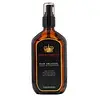What's inside
What's inside
 Key Ingredients
Key Ingredients

 Benefits
Benefits

 Concerns
Concerns

 Ingredients Side-by-side
Ingredients Side-by-side

Glycine Soja Oil
EmollientRicinus Communis Seed Oil
MaskingRosmarinus Officinalis Leaf Oil
MaskingSimmondsia Chinensis Seed Oil
EmollientMentha Piperita Oil
MaskingEucalyptus Globulus Leaf Oil
PerfumingMenthol
MaskingMelaleuca Alternifolia Leaf Oil
AntioxidantCocos Nucifera Oil
MaskingEquisetum Arvense Extract
AstringentAloe Barbadensis Extract
Skin ConditioningLavandula Angustifolia Oil
MaskingTriticum Vulgare Germ Oil
EmollientCarthamus Tinctorius Seed Oil
MaskingOenothera Biennis Oil
EmollientVitis Vinifera Seed Oil
EmollientBenzyl Nicotinate
Skin ConditioningPrunus Amygdalus Dulcis Oil
Skin ConditioningOryza Sativa Bran Oil
EmollientTocopheryl Acetate
AntioxidantBiotin
AntiseborrhoeicArctium Lappa Root Extract
Skin ConditioningGlycerin
HumectantApium Graveolens Seed Extract
AntioxidantRetinyl Palmitate
Skin ConditioningCholecalciferol
Ascorbic Acid
AntioxidantOcimum Basilicum Oil
MaskingPogostemon Cablin Leaf Oil
MaskingSalvia Officinalis Oil
MaskingSilica
AbrasiveUrtica Dioica Extract
AstringentGlycine Soja Oil, Ricinus Communis Seed Oil, Rosmarinus Officinalis Leaf Oil, Simmondsia Chinensis Seed Oil, Mentha Piperita Oil, Eucalyptus Globulus Leaf Oil, Menthol, Melaleuca Alternifolia Leaf Oil, Cocos Nucifera Oil, Equisetum Arvense Extract, Aloe Barbadensis Extract, Lavandula Angustifolia Oil, Triticum Vulgare Germ Oil, Carthamus Tinctorius Seed Oil, Oenothera Biennis Oil, Vitis Vinifera Seed Oil, Benzyl Nicotinate, Prunus Amygdalus Dulcis Oil, Oryza Sativa Bran Oil, Tocopheryl Acetate, Biotin, Arctium Lappa Root Extract, Glycerin, Apium Graveolens Seed Extract, Retinyl Palmitate, Cholecalciferol, Ascorbic Acid, Ocimum Basilicum Oil, Pogostemon Cablin Leaf Oil, Salvia Officinalis Oil, Silica, Urtica Dioica Extract
Cyclopentasiloxane
EmollientDimethicone
EmollientArgania Spinosa Kernel Oil
EmollientHelianthus Annuus Seed Oil
EmollientOlea Europaea Husk Oil
Skin ConditioningSimmondsia Chinensis Seed Oil
EmollientVitis Vinifera Seed Oil
EmollientCitrus Aurantium Dulcis Oil
MaskingLavandula Angustifolia Oil
MaskingCitrus Aurantium Bergamia Fruit Oil
MaskingGeranium Maculatum Oil
MaskingSantalum Album Oil
MaskingRose Flower Oil
MaskingChamomilla Recutita Flower Oil
MaskingCommiphora Myrrha Oil
MaskingStyrax Benzoin Gum
MaskingTocopheryl Acetate
AntioxidantCaprylyl Glycol
EmollientEthylhexylglycerin
Skin ConditioningCyclopentasiloxane, Dimethicone, Argania Spinosa Kernel Oil, Helianthus Annuus Seed Oil, Olea Europaea Husk Oil, Simmondsia Chinensis Seed Oil, Vitis Vinifera Seed Oil, Citrus Aurantium Dulcis Oil, Lavandula Angustifolia Oil, Citrus Aurantium Bergamia Fruit Oil, Geranium Maculatum Oil, Santalum Album Oil, Rose Flower Oil, Chamomilla Recutita Flower Oil, Commiphora Myrrha Oil, Styrax Benzoin Gum, Tocopheryl Acetate, Caprylyl Glycol, Ethylhexylglycerin
 Reviews
Reviews

Ingredients Explained
These ingredients are found in both products.
Ingredients higher up in an ingredient list are typically present in a larger amount.
Lavandula Angustifolia Oil is more commonly known as lavender essential oil. It is considered a fragrancing ingredient.
Lavender imparts a famous scent. While the smell is lovely, this ingredient and may sensitize skin in topical products. This is because about 85% of the oil is made up of linalool and linalyl acetate.
When exposed to air, these two compounds become strong allergens. This ingredient exhibits cytotoxicity at low concentrations; amounts of 0.25% have been shown to damage skin cells.
A study from Japan found this ingredient caused lavender sensitivity after widespread exposure.
Lavender essential oil has some antimicrobial, antibacterial, and anti-inflammatory properties. However, the cons of this ingredient may outweight the pros.
More research is needed to confirm lavender essential oil's effects when used in aromatherapy.
Lavandula Angustifolia is known as the English Lavender and famous for creating purple fields in Provence, France.
Learn more about Lavandula Angustifolia OilThis oil comes from the seeds of the desert shrub called Jojoba. It is more commonly known as jojoba oil, a non-comedogenic oil.
Jojoba oil does not contain fragrance and has many fatty-acids, making it a great soothing ingredient.
It also contains Vitamin E, a great moisturizing ingredient. Vitamin E is also an antioxidant and protects your skin against oxidative damage.
This ingredient humectant properties, meaning it helps draw moisture from the air. This helps keep your skin hydrated.
While jojoba has antibacterial properties, it is only able to kill some strains of bacteria.
Studies also show it helps in wound healing. In fact, Indigenous cultures have used jojoba as a moisturizer and to help treat burns for centuries.
Fun fact: Jojoba oil similar to natural human skin sebum, so it has a great effect on dry skin. It is also promising with helping to regulate sebum production.
Due to its fatty acid content, Jojoba oil may not be fungal acne safe. We recommend speaking with a professional if you have any concerns.
Learn more about Simmondsia Chinensis Seed OilTocopheryl Acetate is AKA Vitamin E. It is an antioxidant and protects your skin from free radicals. Free radicals damage the skin by breaking down collagen.
One study found using Tocopheryl Acetate with Vitamin C decreased the number of sunburned cells.
Tocopheryl Acetate is commonly found in both skincare and dietary supplements.
Learn more about Tocopheryl AcetateVitis Vinifera Seed Oil comes from the grape vine. Grape seeds are a byproduct of creating grape juice or wine.
The components of grape seeds have many skin benefits. Research has found it to be antimicrobial and anti-inflammatory. It also contains many potent antioxidants such as Vitamin E , Vitamin C, proanthocyanidins, polyphenols, flavonoids, and anthocyanins. Proanthocyanidin has been shown to help even out skin tone.
Antioxidants help fight free-radical molecules. Free-radical molecules are capable of damaging our cells and other genetic material. Antioxidants help stabilize free-radicals by donating extra electrons. Grape seed extract may help reduce the signs of aging.
The antimicrobial properties of grape seed may help treat acne. However, more research is needed to support this claim.
Grape seed has also been found to help absorb UV rays. Grape seed extract should not replace your sunscreen.
The fatty acids of grape seed oil give it emollient properties. Emollients help soothe and soften your skin by creating a film. This film traps moisture within, keeping your skin hydrated.
Learn more about Vitis Vinifera Seed Oil